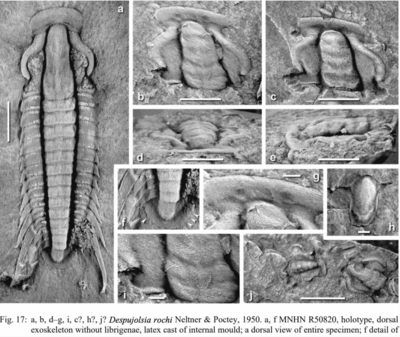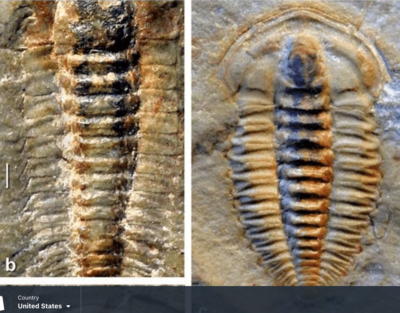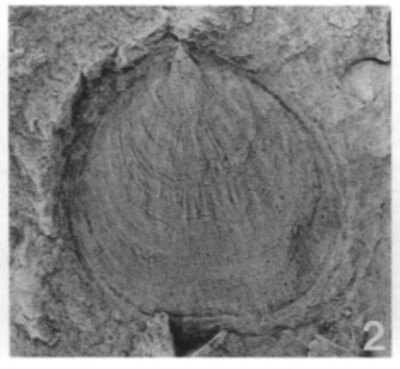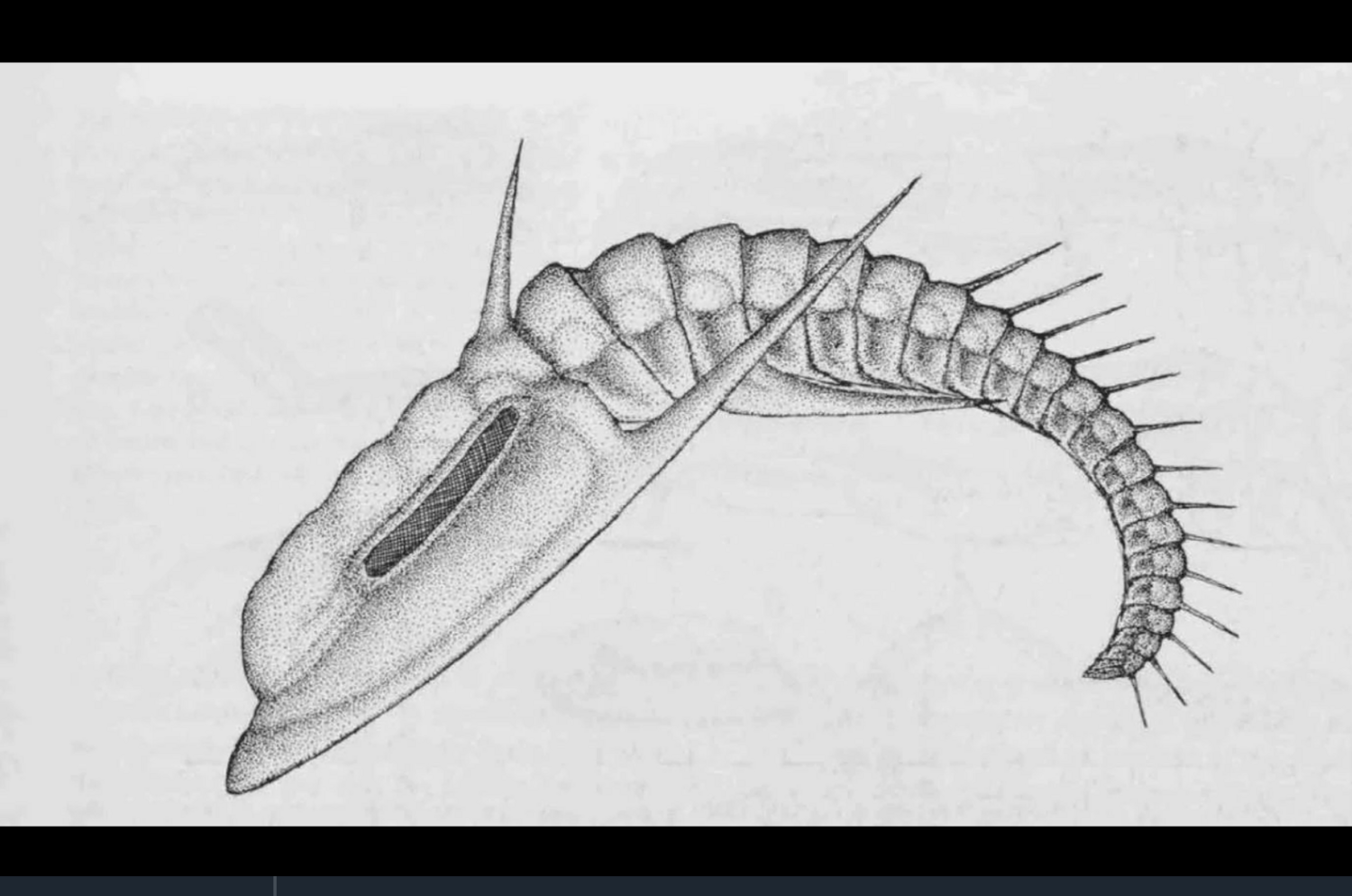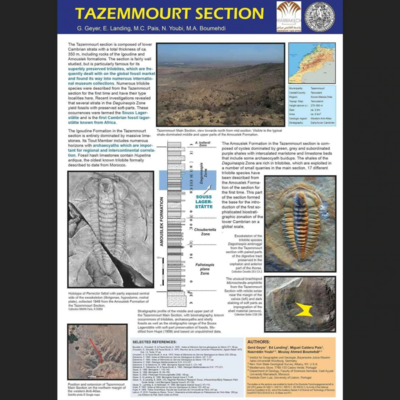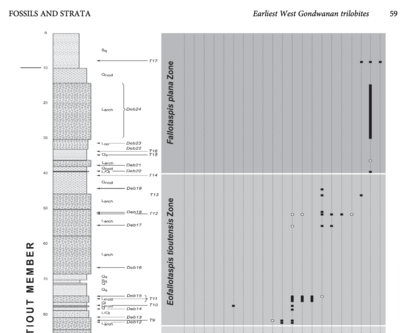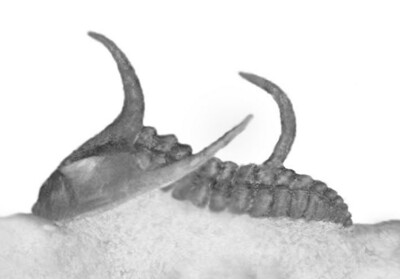The Moroccan fallotaspidid trilobites revisited (Geyer, 1996)
Gerd Geyer (1996).
Abstract. Restudy of the type material and numerous additional specimens of Falllotaspis, Chouberte/la, and Daguinaspis from Morocco suggest several changes in the species-level taxonomy of these genera. Most of HUPE's (1953a) six species of Fallotaspis appear to represent valid species. However, Fallotaspis planospinosa is represented by a poorly preserved specimen, and the species is to be restricted to the holotype. Fallotaspis longispina HUPE, 1953, and F longa HUPE, 1953, are both junior synonyms of 0/ene/lus bondoni NELTNER & POCTEY, 1950, and the valid name is Fallotaspis bondoni (NELTNER & POCTEY, 1950). Choubertella lata HUPE, 1953, is a subjective junior synonym of C. spinosa HUPE, 1953, and C. crassioculata HUPE, 1953, is known only from the holotype, which probably represents a juvenile cephalon. Of HUPE's live species of Daguinaspis, D. latifrons HUPE, 1953, D. subabadiei HUPE, 1953, and D. subabadiei HuPE, 1953, are regarded as junior subjective synonyms of the type species, D. ambroggii HUPE & ABADIE, 1950. Daguinaspis (Epidaguinaspis) angusta HUPE, 1953, and D. (Eodaguinaspis) abadiei HUPE, 1953, are both only known from the holotypes and are dubious. Neither ofthe subgenera Eodaguinaspis and Epidaguinaspis appears tobe valid or required for a subdivision ofthe genus Daguinaspis, and they are rejected herein. Fallotaspis inexspectatus n. sp. is newly established.
The Siberian species Fallotaspis sibirica REPINA, 1965, and F explicata REPINA, 1965, represent the new genus Repinaella. Tagether with the genera Profa/iotaspis REPJNA, 1965, and Lenal/ina REPINA, 1990, earlier assigned to the Fallotaspidinae, it is assigned to the family Archaeaspididae.
The fallotaspidid trilobites Eojallotaspis, Fallotaspis, Choubertella, and Daguinaspis are closely related phylogenetically. As a con- sequence, their Stratigraphie occurrence gives some evidence for their order of descent. They are the index fossils of the lower !Our zones of the biostratigraphical zonation in southern Morocco and are indicative and characteristic of the Issendalen Stage. However, the genus Fallotaspis has a long stratigraphical range, which includes part of the Eojallotaspis Zone and does not define a limited time range useful for international correlations.
The olenelloid and redlichioid phylogeny is reevaluated. A number of morphologic aspects, as weil as the presence of a protaspid larva and the Stratigraphie occurrences, strongly suggest a systematic differentiation of fallotaspidid and olenellid trilobites. Fallotaspidid trilobites are regarded as the ancestors of the such redlichiids as Lemdadella. Olenellids and holmiids, in contrast, represent a different lineage that appears to have given rise to the Xystriduridae.
Important differences between Fallotaspis with Choubertel/a and Daguinaspis are due to the reduced width of the Cephalon in both Choubertella and Daguinaspis. As a result, extended genal spines are absent in Choubertella and Daguinaspis and indicate a modification of the ancestral body plan of Fallotaspis. The characters visible on the carapace present a mosaic of Features known from different olenelloid and redlichioid taxa and do not per se readily define the group. Details on the general morphology and its functional aspects, including aspects of the generat body plan, glabella, cephalic border and frontal area, eye orientation and size, genal ridges and »metaparian suture«, doublure, rostral plate, cephalic segmentation, thorax, pygidium, and cuticular ornament, are described in detail and considered in developing a phylogenetic systematics of these trilobites. The visual surface of the three genera is in a vertical position with its lower and upper margin parallel to the ventral surface of the cephalic border that lay in a horizontal position during life. investigation of intergenal ridges, posterior ocular lines, and associated fractures indicate that the "metaparian suture" of the fallotaspidids does not exist and this type of "suture" is mimiced by cracks, which commence at the posterior end of the visual surface. In Choubertella and Daguinaspis, the visual surface was considerably elevated above the cephalic border, and this Ieads to the assumption that Chouberte/la and Daguinaspis preferably lived on soft substrate as »mud creepers« . The relief o f the ocular lobe helped the animals keep the eyes beyond the sediment. In general, morphologic rcevaluation Ieads to an understanding of the differences between these species and genera and to elucidating evolutionary patterns among the Fallotaspididae, and to deterrnining important differences between them and the olenelloid and holmiid trilobites. Reconstruction ofexuviation supplies additional data.
The articulation of the thoracic segments of Fal/otaspis includes a combination of a flange joint with articulating processes at the axial furrows with fulcra and corresponding swellings ! that acted as limiting marginal connective devices. This articulation permitted an incomplete cylindrical enrollment. Additional discussions summarize facts on the autecology and synecology of Fallotaspis, Chouber- tel/a, and Daguinaspis. A protaspid larva of Fal/otaspis i described for the fir t time. lts shape suggests a benthic mode of life. A meraspid cephalon of Chouberte/la indicates both a well developed intergenal spine and a genal spine that is reduced to a rudimentary structure in adult individuals.
The sclerites of Fallotaspis, Chouberte/la, and Daguinaspis are usually affected by complex diagenetic as weil as taphonomic processes, and their composition differs largely from the original composition ofthe cuticles. In different lithofacies, the exoskeletal composition was specifically altered. The main effect on the mode of preservation results from different grain sizes ofthe siliciclastic Sediments. All of the specimens preserved in fine-grained sandstones and siltstones are composite-molds. ln the usual type of preservation in shale, the primary cuticular substances and fabrics were destroyed and repla ed by such mixed components as argillaceous, phosphatic, and ferritic minerals. Preservational features and the mode of deformation Iead to the assumption that the cuticle of Fallotnspis was slightly less calcified or that the cuticular calcite was more unstable by comparison with redlichiid or ellipsocephalid trilobites.
The circumocular suture in Eofallotaspis, Fallotaspis, Choubertella and Daguinaspis are frequently the locus ~fadditional frac.ture~, which tend to align with the major axes of the cephalon and resulting compactional vectors, a pheno~1enon th~t IS not pa~all~led m tn- l o b i t e s w i t h w e i l d e v e l o p e d f a c i a l s u t u r e . T h i s . i n t u r n , s h o w s t h e i m p o r t a n c e o f a w e i l ~eveloped .fac~al s u t u r e . m . I a r g e r t n l o b 1 t e s . Fr~c tures at the anterior end of thc eye and from the posterior end of the eyes to the postenor cephaltc nm are pnm1t1ve stages of a fac1al suture. Such fractures may hardly be distinguishable from »real« sutures. . . . . .
Most strata with specimens of Fallotaspis, Choubertelfa, and Daguinaspis contain isolated or artJculate~ remains of mdiVI~uals,
not show indication of any notable sorting. Hence, most assemblages appear to be undisturbed by any kmd of sedlmentologlcal or pred- ator/scavenger activity. Beds with abundant assemblages ofspecimens of Daguinaspis in the Amouslek and Taze.mmourt sections ar.e a remarkable exception, and sedimentological as weil as taphonomical facts suggest a pronounced post-martern s1ze- and shape- ort1ng due to lateral transport.
Quantitative statistical analyses were used to define the morphologic variation in the three genera Fallotaspis, Choubertella, and Daguinaspis. They include primarily regre sion analyses, as weil as multidimensional scaling. In addition, the wealth of data allow rein- vestigation ofearlier statistical tests on 0/enus from Sweden, which tumed outtobe apparently insignificant.
This is an open-source publication. Follow all the steps in your email (including signing up to our Store) and you will receive the download link.
